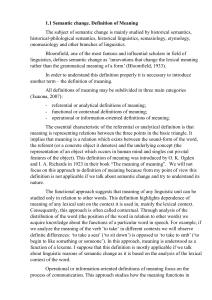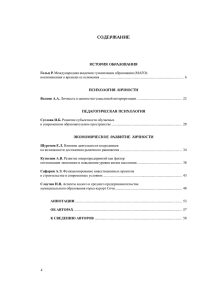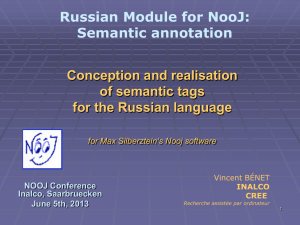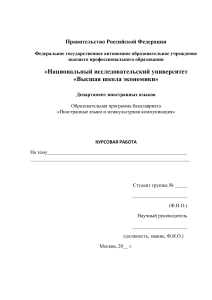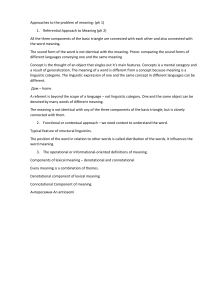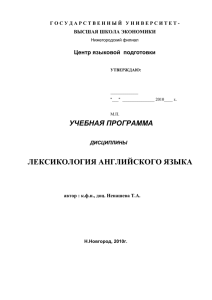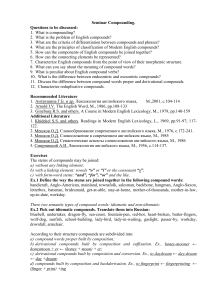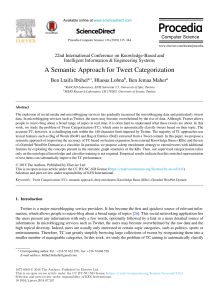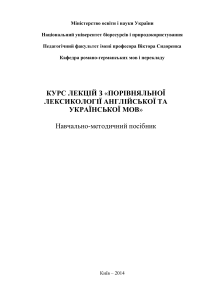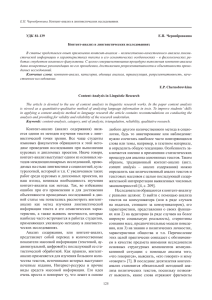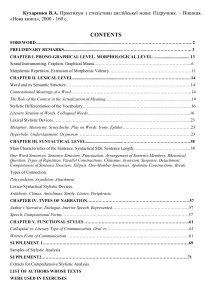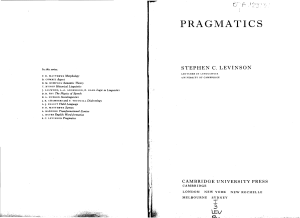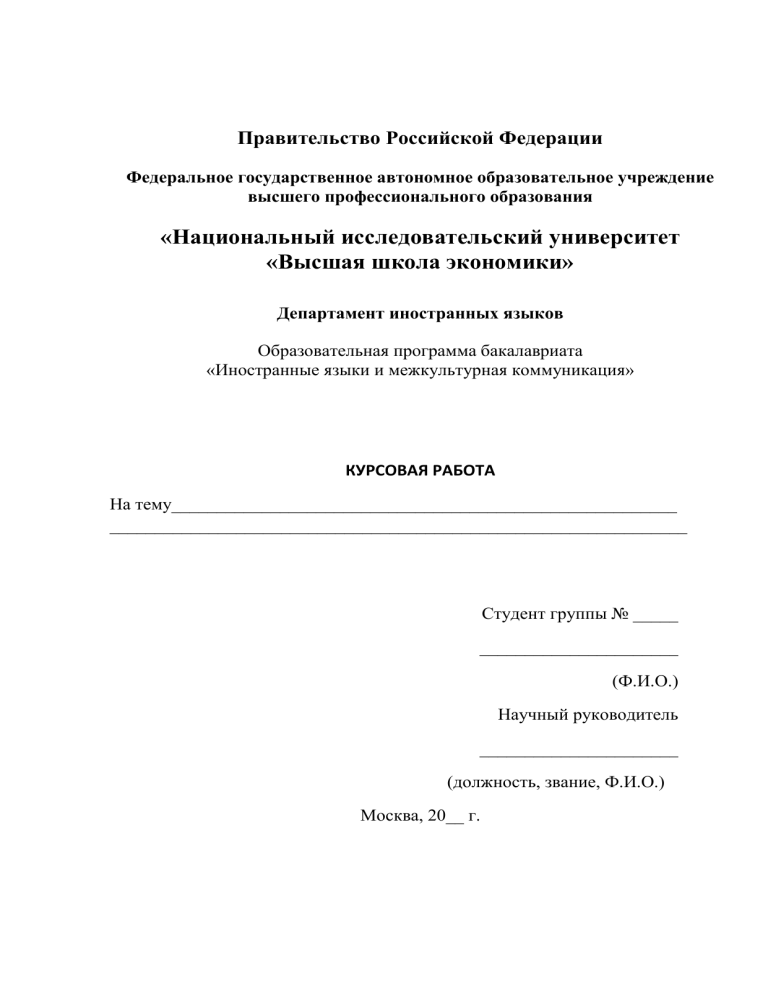
Правительство Российской Федерации Федеральное государственное автономное образовательное учреждение высшего профессионального образования «Национальный исследовательский университет «Высшая школа экономики» Департамент иностранных языков Образовательная программа бакалавриата «Иностранные языки и межкультурная коммуникация» КУРСОВАЯ РАБОТА На тему________________________________________________________ ________________________________________________________________ Студент группы № _____ ______________________ (Ф.И.О.) Научный руководитель ______________________ (должность, звание, Ф.И.О.) Москва, 20__ г. 1 Оглавление Introduction ...................................................................................................................................................... 3 Chapter 1........................................................................................................................................................... 5 1.1 Definition of semantic change. Definition of Meaning. Definition of context ................................... 5 1.1 Historical overview of some theories of semantic change ................................................................... 9 1.3 Mechanisms and results of semantic change ..................................................................................... 13 1.4 Blanks classification of causes of semantic change and typology of semantic change ................... 18 Empirical part ................................................................................................................................................ 18 Conclusion....................................................................................................................................................... 18 References ....................................................................................................................................................... 18 3 Introduction This work is devoted to studying ways semantics of languages change and forces that trigger these changes. The relevance of this theme cannot be overestimated as in today’s globalizing world languages face rapid changes. Understanding processes occurring in the language is crucial for many reasons, as, for example, for the right public policy in terms of language. The awareness of semantic changes enables to follow rapidly changing language picture of the world and as a result helps to adapt to everchanging conditions we live in. The subject of semantic change is studied by historical semantics, historicalphilological semantics, historical linguistics, semasiology, etymology and other branches of linguistics. In this paper semantic change will be regarded from the point of view of cognitive linguistics. Semantic change is an interesting subject of study for many linguists but is a very complex one. During the 20th century, plenty of new classifications and theories appeared which tried to explain the phenomenon of semantic change and factors that influence the process of semantic change. In the middle of the 20 th century, Coseriu stated that language is not a product (ergon) but rather a process (energeia) and this process exists potentially in minds of speakers and becomes reality only in concrete utterances of speakers. This point of view on the language is supported by many linguists and especially by the scientists of school of cognitive linguistics whose theories are gaining strength over the last 35 years (Traugott, 2017). Cognitive linguistic approach highlights pragmatics and importance of the speaking subject as well as his or her hearer. According to cognitive linguistic studies, semantic change is a product of a constant process of human communication and is defined by it. According to their theories there is no firmly fixed meaning of the word, the words are guides for creating meanings in our minds with help of context (Traugott, 2017). The idea that speech is existing potentially in mind of a speaker and its final form is realized in the utterances of the speaker and strongly depends on human mind leads us to two conclusions. Firstly, if the process of production of speech is so individual it implies that mechanisms of semantic change must be very different and difficult to classify. To be exact, we may create different classifications of causes of semantic change and mechanisms of change but it would be almost impossible to create a comprehensive classification that would suit all the semantic changes happening in reality. This idea may be supported by the existence of variety of linguistic theories connected with the subject of semantic change developed in the course of the 20th century. Secondly, semantic change should be strongly dependent on diverse types of contexts or pragmatics. If human reinvents his speech every time he talks there must be some factors that drive this invention and these factors are also 4 multiple and difficult to classify. This paper should provide answers for the question what is the correlation between different types of context or pragmatics and types of semantic change and how to classify them. During the research mainly the works reflecting cognitive linguistics approach to semantic change will be studied. In this paper semantic change will be viewed diachronically. That means that development of the semantic structure of the word will be traced through its development in various historical periods. According to Geeraerts before moving on to classifications of semantic changes and contexts it is crucial to outlive two approaches – ‘semasiological’ and ‘onomasiological’– that dominate in linguistics. These categories are some factors that help us to classify semantic changes and to attribute them to particular groups. The semasiological approach is a9 perspective from form to function: scholars try to answer, how new meanings occur, how these meaning are correlated and how do they change over time while the form of the word remains relatively constant. The second one is a perspective from function to form: scholars study which words are used for expression of particular concepts. Onomasiological (or lexicogenetic) mechanisms involve changes through which a concept comes to be expressed by a new lexeme or an alternative one. This approach intersects with works on vocabulary change a lot as in the course of history the same concepts may be expressed by nonrelated, completely different forms (Traugott, 2017; Зыкова, 2008). It should be mentioned that extension of meanings of one word studied by semasiological approach is itself one of the major mechanisms that trigger onomasiological change (change of the word form while the concept stays the same). Some of the new meanings of the word whose semantics has changed might get a new lexicalization and this will be an illustration of an onomasiological change. Therefore, some of the scientists suppose that semasiological approach should be regarded as more comprehensive one and in this particular sense encompassing the onomasiological approach (Geeraerts, 2009). In this work we will be predominantly concerned with analysis within the frames of the semasiological approach and will study how different words change their meaning without changing their outer form. The object of this research is semantics (meaning of word) and semantic changes (shifts in meaning of word). The subject of this work is how the context (linguistic and extralinguistic) determines different types of semantic changes, nature and results of these changes. The aim is to reveal and describe different linguistic and extralinguistic causes of semantic change and find a connection between certain types of semantic changes and their causes. 5 In order to reach the aim of this research it is important to fulfill few objectives: 1) to study a wide range of sources of information, providing a deep knowledge of the topic; 2) 3) contexts; 4) to study the key terms; to study on examples types of semantic changes occurring in different to find connections between particular contexts and changes occurring in them. Methods of research are observation and comparison of semantic changes in variety of contexts and analysis of those semantic changes in particular contexts. This work includes two parts: the first one is theoretical and the second one is empirical. In the theoretical part we will introduce the key terms for our study. Historical perspective on the studies of causes of semantic change will be also given. After that we will concentrate on mechanisms of semantic change and types of semantic change and will study interdependence of particular types of contexts and types of semantic change occurring in language. In the second, empirical part of this paper a list of words will be analyzed in order to find out how types of semantic change which occurred in the process of development of semantic structure of the word correlated with context and how this correlation influenced development of modern semantic structure of the word. By the analysis, the theory from the theoretical chapter will be applied. Chapter 1 1.1 Definition of semantic change. Definition of Meaning. Definition of context Bloomfield, one of the most famous and influential scholars in field of linguistics, defines semantic change as ‘innovations that change the lexical meaning rather than the grammatical meaning of a form’ (Bloomfield, 1933). Lexical meaning is the meaning of a linguistic unit proper to the word in all possible forms of the linguistic unit and distribution, i.e. its place in relation to other units. Grammatical meaning of a form is an expression in speech of how the words are related (Зыкова, 2008). Paraphrasing the definition given by Bloomfield we may say that semantic change is defined by change of the inner form of the word, while the outer form of the word remains unaltered. How can be semantic change recognized? Bloomfield describes three main methods to recognize semantic shift. 6 Firstly, semantic change may be recognized through analysis of distribution of a form in older written records (Bloomfield, 1933). The King James translation of the Bible, which was made in 1611, says about herbs and trees: ‘to you they shall be for meat’. Obviously, the meaning of the word in the 17th century differs from the meaning it has in modern English. We may presume that the word ‘meat’ previously meant ‘food’ and this assumption will be confirmed after reading of those ancient texts from which the Bible was translated: in those texts, the word occurs exactly in this meaning. Sometimes information about semantics of the word may be found in glossaries composed by ancient scientists. In this case we may receive complete information about a linguistic unit and be sure in this information. Secondly, in other cases comparison of cognate forms from different languages might be very helpful. Cognate forms often appear in related languages and may throw light on whether the word has undergone semantic change (Bloomfield, 1933). For instance, English word ‘chin’ has related forms ‘Kinn’ in German and ‘kin’ in Dutch but Gothic word ‘kinnus’ and all Scandinavian forms from Old Norse to present (from ‘kinn’) mean ‘cheak’. From these facts we may deduce that original lexical meaning of this form has changed either in some of languages or in all of them. Finally, another less certain indication of semantic change might be provided by the analysis of the outer form of the word, its morphological structure (Bloomfield, 1933). The word ‘understand’ did not change its meaning from Old English to the present. However, studying the structure of the word we may conclude that this word was created by means of composition from two constituents ‘under’ and ‘stand’. As the lexical meaning of the compound must have been created by the sum of lexical meanings of its constituents, the word must have meant ‘to stand under’. The probability becomes more likely that the constituent ‘under’ had a meaning ‘among’. This assumption might be confirmed by the existence in German and Latin such words as ‘unter’ and ‘inter’ having the meaning ‘among’. In order to understand the definition of semantic change properly it is necessary to introduce another term – the definition of meaning. All definitions of meaning may be subdivided in three main categories (Зыкова, 2008): - referential or analytical definitions of meaning; - functional or contextual definitions of meaning; - operational or information-oriented definitions of meaning. The essential characteristic of the referential or analytical definition is that meaning is representing relations between the three points in the basic triangle. It implies that meaning is a relation which exists between the sound-form of the word, 7 the referent (or a concrete object it denotes) and the underlying concept (the representation of an object which occurs in human mind and singles out pivotal features of the object). This definition of meaning was introduced by O. K. Ogden and I. A. Richards in 1923 in their book “The meaning of meaning”. We will not focus on this approach to definition of meaning because from my point of view this definition is not applicable if we talk about semantic change and try to understand its nature. The functional approach suggests that meaning of any linguistic unit can be studied only in relation to other words. This definition highlights dependence of meaning of any lexical unit on the context it is used in, mainly the lexical context. Consequently, this approach is often called contextual. Through analysis of the distribution of the word (the position of the word in relation to other words) we acquire knowledge about the functions of a particular word in speech. For example, if we analyze the meaning of the verb ‘to take’ in different contexts we will observe definite differences: ‘to take a seat’ (‘to sit down’) is opposed to ‘to take to smb’ (‘to begin to like something or someone’). In this approach, meaning is understood as a function of a lexeme. I suppose that this definition is mostly applicable if we talk about linguistic reasons of semantic change as it is based on the analysis of the lexical context of the word. Operational or information-oriented definitions of meaning focus on the process of communication. This approach studies how the meaning functions in specific situation of communication rather than what meaning really is. Operational approach appeared later than the other two approaches and as a result of growing interest to the communicative aspect of the language. Information-oriented approach distinguishes between meaning and sense. According to this definition meaning is the direct information given by the constituents of the utterance and sense is the information added to the extralinguistic situation. Thus, the sentence ‘Mark came too late’ gives direct information about Mark’s late arrival. However, besides the direct information the sentence might imply that ‘Mark failed to keep his promise’, ‘Mark happened to be in accident’, ‘Mark did not want to come’, etc. Operational definition intersects with perspective on semantic change as it is provided by cognitive linguistics and we will go back to this definition later discussing extralinguistic causes of semantic change. In order to classify the variety of semantic changes properly it is essential to make a further distinction within the range of diverse semasiological mechanisms. This distinction involves changes of denotational (or referential), connotational and pragmatic aspects of meaning (Geeraerts, 2009). Aspects of meaning are the basic factor for classification of semantic changes. Many linguists classify semantic changes according to what aspects of meaning change. 8 The denotational aspect of meaning is the part of lexical meaning which represents a correlation between the name and the object, phenomenon, process or characteristic feature of concrete reality (or thought as such), which is denoted by the given word (Зыкова, 2008). The term ‘denotational’ originates from the English word ‘to denote’, which means ‘be a sign of, indicate, stand as a name or symbol for’. Providing an example, denotational meaning of the word ‘lifeboat’, which can be found in Collins Dictionary, is ‘a small boat that is carried on a ship, which people on the ship use to escape when the ship is in danger of sinking’. During communication significant amount of information is conveyed through the denotational aspect. The connotational aspect is the part of lexical meaning which reflects feelings, emotions, attitudes of a speaker to the topic he is talking about. Connotational aspect of meaning provides additional information during the process of communication. Types of attitude to the subject a person speaks about may also differ. Four main types may be outlined based on: 1) the emotive charge. An example might be a pair of words ‘mother’ and ‘mom’. Emotive charge is documented in dictionaries. We can see it in form of remarks ‘formal’ or ‘informal’; 2) evaluation, which may be negative or positive. Change of positive attitude to negative one or vice-versa causes such semantic changes as amelioration or deterioration of meaning. For example, from c. 1100 the word ‘knight’ had a meaning ‘military follower of a king or other superior’ (Online Etymology Dictionary). But in 500 years the meaning changed having gained more importance and in 16c. in became a rank in nobility. 3) intensity (or expressiveness), for example the verbs ‘love’ and ‘adore’ have the same denotational component but impression made by these words in the course of speech would be very different; 4) imagery, e. g. ‘to wade’ means ‘to walk with great effort’ (through mud, water). However, this word may be also used figuratively: ‘to wade through the book’). The pragmatic aspect of meaning is a part of lexical meaning that somehow provides information about the situation of communication. Pragmatic aspect may give information about ‘time and space’ relationship of the participants, information about participants and language communities they originate from, information about the tenor of discourse and register of communication (Зыкова, 2008). Another term, which is crucial for discussion of semantic change in this paper, is definition of context. In this paper we will not apply the term ‘context’ in its traditional meaning. From the cognitive linguistic perspective semantics and pragmatics are inseparable, ‘language change is a consequence of inherent 9 characteristics of man's mind and human social interaction’ (Blank, 1999), i.e. context is actually a cause of semantic change. Under context we understand those social, cultural and other circumstances that surround people while communication. These circumstances are the factors that influence human mind and push languages to semantic changes, hence we may put a sign ‘equal’ between context and causes of change. Under types of extralinguistic reality we will understand various types of situations or circumstances which might influence the development of the semantic structure of the word or causes of semantic change. One remark should be made about causes of semantic change. In traditional classifications many linguists subdivide linguistic and extralinguistic causes (or contexts) of semantic change. According to cognitive linguistics, ‘language change is not inherent in language itself, although it occurs at any time in any language, nor are there certain tendencies (e.g. "simplification") inherent in language’ (Blank, 1999). Thus, cognitive linguistics describe general motivations of semantic change without subdivision on linguistic or extralinguistic causes. Cognitive linguistics regards natural languages as a product of social interaction. 1.1 Historical overview of some theories of semantic change The twentieth century was a period when studies of semantic change have been pushed of the stage of modern linguistics by synchronic studies (Riddell, 1999). Nevertheless, some scholars were bothered by the question what causes actually trigger changes and many of their works conveyed revolutionary ideas. As the primary concern of this paper is to describe causes of semantic change and their influence on types of semantic changes occurring in language by means of cognitive linguistic approach, we will not focus on linguistic reasons for semantic change listed in classifications of different scholars and will predominantly describe extralinguistic causes (or social and cultural context). The development of theories of semantic change will be traced through the works of three linguists: Antoine Meillet, Stephen Ullmann and Gustaf Stern. Antoine Meillet wrote at the turn of 20th century (1905), Gustaf Stern created his theory in 1931 and Stephen Ullmann described his theory in the middle of the 20th century. All the works serve a foundation for modern linguistic theories of semantic change. One of the first scholars who wrote about causes of semantic change was Antoine Meillet, a French linguist, one of the founding fathers of sociolinguistics (Riddell, 1999). He worked at the beginning of the twentieth century and offered a classification of causes of semantic change consisting of three main categories. In Meillet’s classification primarily linguistic causes (negative polarity) are on the first place in the list. The second category of causes according Meillet covers variations of sense which appear in the course of time because of changes of the referent. Such 10 sense alterations often appear in language but people rarely notice them. For example, the word ‘plume’ in French means both ‘feather’ and ‘fountain pen’ and this may be explained by the historical fact that ink pens were originally fashioned by putting a feather on the nib. Final and the most important cause of change from point of view of the scholar is the contact between different social classes and borrowings that result from them. In his articles, he supports the statement of another linguist Meringer that lexical items borrowed by broad speech community from a particular social group extend their semantics while narrowing of meaning occurs when a relatively small group of people starts to use a word exploited by broad speech community. For example, Latin words ‘ponere’ (‘to place’), ‘cubare’ (‘to lie asleep’), ‘trahere’ (‘to draw, drag’), ‘mutare’ (‘to change’) flowed from the general speech community into the rural community. Over the centuries, a semantic narrowing took place. This is clearly illustrated by the meaning of modern French words ‘pond re’ (‘to lay eggs’), ‘couver’ (‘to sit on eggs’), ‘traire’ (‘to milk a cow’) and ‘muer’ (‘to shed the coat, to moult’). The process of semantic widening may be illustrated by the history of a French verb ‘arracher’ that is rooted in Latin. The expression ‘ex radicare’ meaning ‘tirer la racine’ (‘pull out the roots’) was widely used in agricultural society but in the course of time this word became part of vocabulary for general speech community. Today the verb ‘arracher’ is used figuratively in such French phrases as ‘arracher quelqu'un de son lit’ and ‘arracher de l'argent’ but this phrases are not connected with the concept of roots at all. Meillet’s classification was harshly criticized by other linguists for its simplicity and inability to describe all complex mechanisms of change. For example, Ullmann criticized Meillet’s list because the linguist did not add psychological reasons to his classification while psychological reasons explain such phenomena as taboo or euphemisms. However, the author of classification admitted himself that his classification was not comprehensive enough and it is very difficult to create such a classification provided the complexity of factors involved. Stephen Ullmann’s theory of semantic change was labelled ‘The Functional Classification’. Ullmann’s reflections on semantic change were summarized in his books Principles of semantics (1957) and Semantics (1962) and this theory became one of the most popular for several decades (Blank, 1999). His classification was built based on classifications of other scientists whose classifications seemed to be not comprehensive enough: Wundt, Schuchardt, Roudet, Gombocz (Riddell, 1999). It also included some features of Meillet’s theory (Blank, 1999). His scheme of classification had such skeleton: A. Semantic changes due to linguistic conservatism; B. Semantic changes due to linguistic innovation; I Transfers of names: 11 a) through similarity between the senses b) through contiguity between the senses II Transfers of senses: a) through similarity between the names b) through contiguity between the names III Composite changes. The first cause of semantic change in this list parallels the second cause listed in Meillet’s classification. Ullmann says that all other changes are the outcome of linguistic innovations, no matter how did they appear in language: voluntarily or involuntarily, consciously or subconsciously. Transfer of names through similarity can be exemplified by the word ‘leg’, which is used both for human limbs and metaphorically denotes parts of the table. An example of metonymy or of the transfer of names through contiguity between the senses may be the word ‘town’ when it denotes the inhabitants (‘the whole town was shocked’). The next category ‘transfer of senses’ includes two subdivisions: transfer of senses through similarity between the names and transfer of senses through contiguity between the names. Some linguists call transfer of senses through similarity between the names ‘folk etymology’. The expression ‘sand-blind’ was developed by means of ‘folk etymology’ from the word ‘sam-blind’ (‘sam’ from Latin ‘semi’). Transfer through contiguity between the names covers semantic changes due to syntagmatic associations which developed between names occurring frequently in the same context: ‘capital fund’, ‘capital city’, ‘capital letter’ are subject to ellipsis and the outcome of change is the independent use of the word ‘capital’ for all these phenomena. Ullmann’s classification is more comprehensive than Meillet’s model but remains a subject to criticism, especially from the point of view of cognitive linguists. Blank calls Ullmann’s classification ‘an eclectic collection of motivations, necessary conditions and accessory elements’ (Blank, 1999). His classification mainly describes results of changes but do not provide explanation of the actual causes of semantic change. Blank states that ‘Ullmann’s list lacks both cognitive and empirical background’ (Blank, 1999). The great advantage of the next theory, which was introduced by Gustaf Stern, is that it was based on factual evidence and on empirical data (Riddell, 1999). This theory was labelled ‘Empirical’. Stephen Ullmann found this theory very convincing and indicated different approaches used in his own theory and in Stern’s theory. From his point of view these two theories might be used in conjunction quite effectively because Ullman’s theory is purely deductive and Stern’s theory represents empirical view on the problem of semantic change. 12 Stern was the first scholar to point out the difference between semantic change and sense fluctuation (Riddell, 1999). He was concerned with the question how psychological processes and semantic change are connected. He exemplifies the difference between semantic change and sense fluctuation by the perception of the word ‘Kodak’ by photographer and an ordinary man or woman. Photographer sees ‘Kodak’ as a sophisticated machine with complex mechanisms and functions while ordinary people see it merely as an instrument for recording a visual scene. Thus, sense fluctuation is the slight difference in perception of objects of reality by diverse people but cannot be called semantic change because the object named by the notion remains the same. Stern subdivides semantic change in seven classes and organizes them in such order: A. External causes (Class I Substitution) B. Linguistic causes i. Shift of Verbal Relation a. Class II Analogy; b. Class III Shortening ii. Shift of Referential Relation a. Class IV Nomination; b. Class V Transfer iii. Shift of Subjective Relation a. Class VI Permutation; b. Class VII Adequation This classification is quite sizable and as the aim of this paper is to describe correlation of semantic structure of the word with context of situation (or extralinguistic context), we will focus only on the first category of changes presented in Stern’s classification. Stern distinguishes between three types of substitution. The first category parallels the category of semantic change due to linguistic conservatism presented in Ullmann’s classification. Thus, the first category describes semantic changes due to change of referent in the course of time (as in the French word ‘plume’). The next subcategory describes changes of our knowledge about referent though the referent remains the same. For instance, the word ‘atom’ might be a great illustration of such type of change: previously it meant an indivisible extremely minute body but now our knowledge about the structure of atom has expanded and the meaning changed. Stern also describes change in our attitude to referent as another category. Emotive response to such phrase as ‘women’s suffrage’ has diminished over time. 13 To sum up, theories describing semantic change in the 20th century are quite diverse. However, it should be mentioned that authors of these theories did not manage to describe semantic change in a fully comprehensive way. ‘Traditional historical semantics have not succeeded in conceiving a consistent theory of the motivations for semantic change, but rather they provide a mix of mechanisms, such as metaphor, necessary (but not sufficient) conditions, such as collocations, and actual causes’ (Blank, 1999). In this paper, typology of causes of semantic change by Blank will be applied for studying connection between causes of semantic change and mechanisms of semantic change they trigger. His classification of causes is based on empirical approach and this allows ‘to reduce the risks of omitting types that are less striking than others’ (Blank, 1999). His typology is mainly concentrated on different types of motivations for semantic change rather than on mechanisms. This makes Blank’s typology the most convenient for fulfilling objectives of our research, as clear division between causes of semantic change and mechanisms of semantic change allows to outline correlation between them more exactly. 1.3 Mechanisms and results of semantic change In this part we are going to outline mechanisms of semantic change or types of semantic change before to move on to description of how contexts of semantic change correlate with different types of change. We will also describe results of semantic change which were falsely regarded as mechanisms of change in previous classifications outlined in the historical overview. Majority of scholars are unanimous on the issue that semantic change is a long-term process. To be exact, this change in meaning occurs very quickly in mind of a speaker or writer but years may pass till this innovation becomes part of language. The semantic change itself is a result in change of the use of a particular word and semantically related forms in the speech (Bloomfield, 1933). How does semantic change happen? What process changes meaning of a linguistic unit? According to Bloomfield, if a word form used in meaning A later changes its meaning to meaning B, the semantic change can be explained by minimum two shifts (Bloomfield, 1933). Firstly, the use of the form becomes expended: in situations, where only meaning A was used initially people also start to use the word in the meaning B. Secondly, narrowing of the meaning happens: the form is used in the meaning A more rarely until it is used only in the meaning B. At this stage, semantic shift becomes completed. Ordinarily, the first stage of the process implies that the form expanding its meaning crowds out some other forms used in the situations when meaning B is required. On the second stage, some other forms take place of the form, which has undergone semantic change, and replace it in the situations when meaning 14 A is required. Bloomfield illustrates his explanations by semantic change of the word ‘meat’, which has already been discussed in the first part of this chapter. Probably, the first scholar who mentioned that semantic change consists of stages of extension of meaning and restriction of meaning was Hermann Paul (Bloomfield, 1933). He spotted that people usually use words in their speech in meanings they have previously heard from other people. We may use words in different meanings during communicative acts. These meanings may be general or occasional. If we say ‘town’ and mean ‘a large settlement of people’ or say ‘head’ describing an animal, we use words in their general meaning. However, in most cases people use occasional meanings of words and these meanings have a strongly marked pragmatic component. For example, people saying ‘Tom bumped his head’ mean a particular person’s head. If somebody living in the suburbs of a city says ‘I am going to the city’, everybody understands that this man or woman indicates not another city but the center of the city she or he lives in. Central meanings of words are usually general, while marginal meanings are occasional. Marginal or occasional meanings are used when some circumstances make usage of the central meaning impossible. Consequently, if the situation around the speaker changes in the way that occasional meaning of word or a range of occasional meanings are frequently heard by speaker, he or she will use the form in similar situations. Using an occasional meaning speaker will think of this meaning as of the central one. For instance, in later Middle Ages the word ‘Kopf’ in German had the meaning ‘cup, bowl’ and the modern meaning of this word ‘head’ was marginal. Hence, according to Bloomfield, semantic shift happened after many speakers have heard this word in its marginal meaning and started to use it in this meaning as in the central one. This theory describes process of semantic change as a universal law functioning independently from human mind. This theory gives a good explanation of how central and marginal meanings of words can change and how the context of situation may influence this change. However, Bloomfield’s theory fails to give an explanation of how completely new lexical meanings appear. 15 The description of how new meanings occur thanks to human creativity may be found in the theory of cognitive linguist Helmut Lüdtke. He describes a tripartite model of semantic change: CREATIVITY ~ IMITATION ~ DIFFERENCE or, in other terms: INNOVATION ~ DIFFUSION ~ RESULT This type of development of language also implies semantic expansion of existing lexical items through metaphor or metonymy. Metaphor and metonymy are actually those mechanisms whose connection with causes of semantic change we are to analyze in the next part of this chapter. Returning to the theory of Helmut Lüdtke, as it is clearly seen from the given scheme, the process of semantic change consists of three parts. We may distinguish first metaphorical use of lexical unit being an act of human creativity as the first stage. The stage of diffusion denotes frequent use of this metaphor by speakers being aware of using a newly created metaphor. The last stage is characterized by blurring of understanding by speakers of original semantic structure of the word and development of polysemy. At this stage, the lexical unit starts to be used by next generations of speakers. The word ‘law’ is a good example of the word that changed its semantic structure metaphorically and of how speakers forgot what of the meanings was originally the central one. This word previously meant ‘legislation’ and its meaning in the collocation ‘laws of nature’ was developed through metaphor. However, nowadays this word does not seem to have metaphoric meaning in this collocation anymore and many people presume wrongly that the meaning of this word in collocation ‘laws of nature’ must be elder than the meaning ‘legislation’. This theory parallels Bloomfield’s explanations and expends them. Cognitive linguistics theory describes mechanisms of metaphor and metonymy and outlines semantic change not only as a natural process running without involvement of human consciousness but also highlights significance of human creativity in semantic change. Metaphor or similarity of meanings is a process of associating two referents on the ground of their resemblance (Зыкова, 2008). An example for metaphor may serve the word ‘hand’ in the meaning ‘pointer of a clock or a watch’. This meaning was acquired in the 16th century based on the similarity of functions performed by the hand and the clock-pointer. While studying different classifications of semantic change many interesting lower-level regularities may be noticed (Geeraerts, 2010). Now we will present classification of metaphors made by German linguist Waag in1908, his classification 16 remains one of the most comprehensive and hence, very convenient for analysis which will be carried out in the second chapter. 1) Metaphors based on similarities of shape and appearance. For instance, names of body parts may be transferred to artefacts, plants, animals, landscape features. ‘Auge’ (German ‘eye’) is transferred to the spots on the tail of peacocks, on wings of butterflies and provides name for globules of fat in soup. 2) Metaphors based on similarities of structural position. In this case, the similarity is not based on similarity in appearance but on similarity of relationships of the whole and its part, for example. German word ‘Kopf’ does not only denote part of human body but also means ‘top of the mountain’. Similarity is based on structural relationships: head is the upper part of human body as well as top of the mountain is the upper part of the mountain. 3) Metaphors based on functional similarities. This type of metaphor involves resemblance of functions of the source and the target. People may call someone ‘die rechte Hand’ ‘the right hand’ because this person is very helpful and irreplaceable. The right hand is the most useful helper and instrument. 4) Metaphors relating space and time. This type occurs when people perceive time as a spatial dimension: ‘Zeitpunkt’ ‘point in time, exact moment’, ‘Zeitraum’ ‘area in time, i. e. time period’. 5) Metaphors relating space and quantity. Such metaphors describe with help of spatial characteristics some abstract quantities and intensities: ‘grosser Hitze’ ‘big heat’, ‘hohe Alter’ ‘high age’. 6) Metaphors relating sensory domains. In such metaphors words used for expression of perception of sensory information from one domain are employed by description of information perceived from another sensory domain: ‘knallrot’ ‘loud, glaring red’ connects hearing and vision, ‘scharfer Klang’ ‘sharp sound’ connects touch and hearing. 7) Metaphors relating corporal and cognitive phenomena. Similarity of actions performed by human body and some psychological phenomena: ‘begreifen’ ‘understand’ (from ‘greifen’ ‘to grab’). Metonymy or contiguity of meanings implies the semantic process of associating two referents one of which is strongly connected with another or performs its part (Зыкова, 2008). The word ‘board’ changed its sense metonymically several times in the course of history. Original meaning of this word in Old English was ‘piece of timber sawn flat and thin, longer than it is wide, wider than it is thick, narrower than a plank’. In late Old English or early Middle English, the sense was extended to include ‘table’ (because tables were made of such pieces of wood). In 1570s the word acquired the meaning ‘table where council is held’ and later the name 17 was transferred to ‘leadership council, persons having the management of some public or private concern’ in 1610s based of contiguity. It is worth mentioning that the concept of contiguity should not be regarded in its narrow sense of spatial proximity. This concept is broader and besides spatial proximity includes associations in temporal or causal domain (Geeraerts, 2010). We may subdivide metonymy in many classes. Some linguists define synecdoche as a subtype of metonymy. The classification we will employ for analysis is drawn up by Geeraerts (2010) and includes classes that were segregated by such scholars as Paul, Waag, Nyrop, and Esnault. 1) Spatial part and spatial whole. ‘Tony Blair was the Prime Minister of England’ (England stands for UK as a whole). 2) Temporal part and temporal whole. German ‘morgen’ denoting ‘tomorrow’ (‘morgen’ ‘morning’, part of the day). 3) Location and located. ‘The whole theater was in tears’ (i. e. people in the theatre). 4) Effect and cause. Greek ‘phobos’ ‘flight’ for ‘fear’. 5) Subevent and complex event. ‘Father is cooking potatoes’ (cooking potatoes stands for preparing an entire meal). 6) Characteristic and characterized identity. ‘We need more brains’ (i. e. smart people) 7) Producer and product. ‘I am reading Tolstoi’ (his works). 8) Controller and controlled. ‘Schwarzkopf defeated Iraq’ (i. e. the army). 9) Container and contained. ‘To drink a bottle’. 10) Material and object. French ‘carton’ for ‘cardboard box’. 11) Temporal container and contained. ‘The nineteenth century was historyminded’. 12) Location and product. ‘China’ (the country, the tableware originally produced there). 13) Possessor and possessed. ‘Little Red Riding Hood’. 14) Action and participant. ‘To author a book’. 15) Action and instrument. ‘The pen is mightier than the sword’ (‘writing is more powerful than fighting’). 18 16) Piece of clothing and person. French ‘une vieille perruque ‘an old wig’ (‘old person’). 17) Member entity and collection. ‘Fritz’ for ‘a German soldier’, ‘the German army’. 1.4 Blanks classification of causes of semantic change and typology of semantic change This paragraph may be conditionally subdivided in two parts. On the one hand, in this paragraph Blank’s classification of semantic change will be described. On the other hand, we will seek for some correlations between causes of semantic change and types of semantic changes discussed in the previous paragraph. This part will present our hypotheses of this correlation. George K. Zipf summed up the general motivation for semantic change in 1949 and since that time, linguists remain unanimous on the issue. According to Zipf, the main motivation of any speaker is to achieve success and to reach the goal of communication (Blank, 1999). Hence, the reason why semantic change happens should not be sought in the language itself but rather in pragmatic goals of the speaker. Cognitive linguists deny the existence of such tendencies in the language as simplification and call on the linguists to regard language change as a consequence of inherent characteristics of human mind and human social interaction (Blank, 1999). Such pragmatic view on language change implies that speakers produce innovations when they feel that this might be a successful strategy in particular situation of communication. Innovations in speech allow to convince the hearer, if they are relevant for act of communication. Speaker is also expressivity-oriented and this is another motivation fo Empirical part Conclusion References 19 1. Blank, A. (1999). "Why do new meanings occur? A cognitive typology of the motivations for lexical semantic change". In Blank, A. & Koch, P. (Ed.), Historical Semantics and Cognition, (pp. 61–90). 2. Riddell, P. (1999). Theories of semantic change: Three Approaches from the First Half of the 20th century. Semantic Change in Malay/Indonesian, MA (Qual.) thesis, Australian National University. 3. Bloomfield, L. (1933). Language. New York: Allen & Unwin. 4. Traugott, E. (2017). Semantic Change. Oxford Research Encyclopedias. DOI:10.1093/acrefore/9780199384655.013.323. 5. Geeraerts, D. (2010). Theories of Lexical Semantics. New York: Oxford University Press Inc.. 6. Зыкова, И. В. Практический курс английской лексикологии = A Practical Course in English Lexicology: учеб. пособие для студ. лингв. вузов и фак. ин. языков/И. В. Зыкова. – 3-е изд., стер. – М.: Издательский центр «Академия», 2008. – 288 с. 7. Арнольд, И. В. Лексикология современного английского языка: Учеб. для ин-тов и фак. иностр. яз. – 3-е изд., перераб. и доп. – М.: Высш. шк., 1986. – 295-е., ил. – На англ. яз. 8. Lüdtke, H. (1999). "Diachronic semantics: towards a unified theory of language change?" In Blank, A. & Koch, P. (Ed.), Historical Semantics and Cognition, (pp. 49–60).
